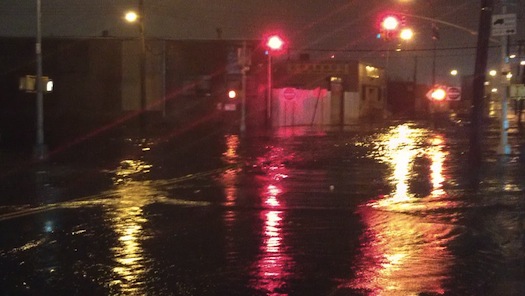

Earlier today, New York City’s Mayor Bloomberg rolled out a wide-reaching, $20 billion plan to fortify the city against the future effects of climate change, which–according to the latest data from the New York City Panel on Climate Change he convened in 2008–could be even worse than we thought.
“We have to look ahead – and anticipate any and all future threats, not only from hurricanes – but also from droughts, heavy downpours like we had last week, and heat waves, which may be longer, and more intense, in the years to come,” Bloomberg said according to his prepared remarks.
After Hurricane Sandy, the New York City Panel on Climate Change updated its 2009 report on how climate change would impact the city. The June 2013 report informed his new plan for storm preparation infrastructure to be readied over his last 200 days in office and beyond. Today, among other things, he called for greater flood barriers, both natural and manmade, as well as a stronger grid system.
“As bad as Sandy was, future storms could be even worse,” he said. “In fact, because of rising temperatures and sea levels, even a storm that’s not as large as Sandy could – down the road – be even more destructive.”
The new climate change report estimates that sea levels could rise by 2.5 feet by the 2050s–twice the rate projected in the first report in 2009. Bloomberg officials estimated that 800,000 NYC residents will live in within the borders of the 100-year floodplain–up to a quarter of the city’s landed area–by that time, according to The New York Times. That’s double the number of people estimated by the latest FEMA maps.
The plan to prevent future Sandy-level destruction calls for a restoration of wetlands and natural dune systems to combat coastal flooding, the construction of surge barriers to stop overflow from rivers and creeks, and bulkheads and levees, and even building elevated communities.
The mayor called for building an elevated community on the Lower East Side, called “Seaport City,” that would be above the flood level.”In more heavily developed parts of our City that saw flooding, we’re also recommending a combination of permanent elements and flexible flood protection systems that can be temporarily fortified before a storm rolls in, and then put back in storage for the next time,” he said. Based on the design of Battery Park City, a planned community created to withstand flooding, he called for building an elevated community on the Lower East Side, called “Seaport City,” that would be above the flood level.
In response to grid failures that left much of the city without power, he outlined goals for a more resilient electrical system, including establishing a Planning and Resiliency Office in the city’s IT office. This has become increasingly important as large blackouts have become common during extreme weather events in the U.S., with more than 100 mass outages a year, as we noted back in our February issue.
He also threw down the gauntlet for telecommunication companies, saying: “Here, the City has some leverage: we have franchise and other agreements that let telecom companies use our streets for wiring. Well, if they want to continue using our streets, they have to make resiliency a priority.” According to the plan, the city will develop restoration and repair standards for power and telecommunications providers, and work with utility companies to strengthen the grid (in some as-yet-unspecified way).
Theoretically, these strategies should make the city more flexible, and thus more resilient to the weather extremes climate change may bring. However, the plan hasn’t been fully funded yet: The $20 billion will come from a combination of existing city funds and expected federal disaster relief, according to the mayor’s office, but $4.5 billion still has to be located. Plus, as Bloomberg himself noted, since his plan will require more time than he has left in office, it’ll also be up to his successor to implement the plan in the long run.
The long-term timeline for many aspects of the plan has yet to be worked out, though the implementation section sets certain goals (such as the establishment of a resiliency office) to be met during 2013. The Bloomberg administration hopes to pass legislation requiring the Office of Long-Term Planning and Sustainability to issue an updated resiliency plan every four years starting in 2017.
